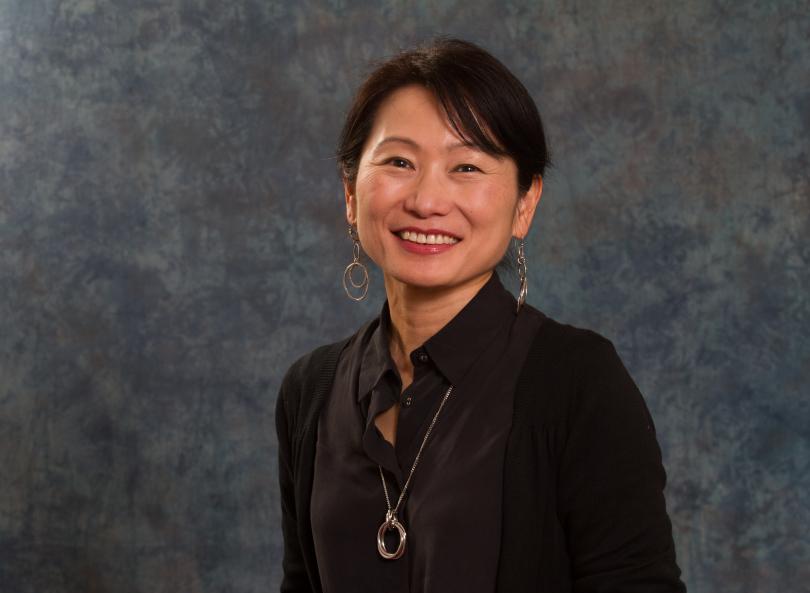By Richard LeComte

LEXINGTON, Ky. -- After years of military rule and devastating war, women in Japan led the effort in promoting peace. During the Cold War, peace activism was considered a communist activity, but the women’s identities as mothers enabled them to avoid the label. The struggle of these women fascinates Akiko Takenaka so much that she wrote a book about it.
“They said, ‘We are mothers, we produce lives, and therefore we are the protectors of lives. We care about children the most, and we must protect our children,’” said Takenaka, associate professor of history at the University of Kentucky and inaugural director of the Global Asias Program.
Takenaka’s book, “Mothers Against War: Gender, Motherhood, and Peace Activism in Postwar Japan,” is due out in 2024 from the University of Hawai’i Press. She follows the women’s movement as they resisted allowing Japan to rearm to a certain degree amid the Cold War.
Although peace movements had started earlier in modern Japanese history, these mothers resonated with the post-war Japanese public, especially as they shunned easy political labels.
“People would accuse them of being communists, but they were able to avoid that labeling because they could say, ‘Oh, no, no, no, we’re not political,’” she said. “‘We are just mothers. I am just trying to protect my children.’”
But the fact that they were presenting themselves in the traditional role of mother had the effect of holding back progress for women in a patriarchal society.
“It pigeonholed them into the domesticity, because they are only identifying themselves as mothers even when they are professional women,” she said. They were able to have their voices heard, but at the same time, it was undermining their status. “It ends up being an anti-feminist project in a way. That is why I wanted to think about their motivations. I primarily look at the 1950s, which means that it is a given that women are mothers. A typical woman had three or four children at the time. Right now, Japan’s birthrate is 1.3.”
She also places the mothers’ peace movement in the broader context of the Cold War, as the United States pushed Japan to accept bases and support U.S. military after the communist revolution in China and during the Korean and Vietnam wars.
“United States’ policy shifts from democratizing Japan to transforming it into a convenient partner — a bulwark against communism,” she said. “That is the word (Gen. Douglas) MacArthur used at that time. After the People's Republic of China was established, the United States looked at Asia and saw that communism needed to be contained. And to do that, Japan was very convenient. The US provided Japan with resources so it could become a powerful ally. The United States created a lot of bases in Japan and fought the wars in Korea and Vietnam from Japan.”
Japanese protesters were reluctant to criticize the United States directly; instead, they portrayed the bases as a harmful influence on the bases’ environs.
"Instead of criticizing the bases, they pointed out that there were a large number of Japanese prostitutes around the bases as well as rest and recuperation centers,” she said. “Activists, instead of criticizing their bases, started to criticize the women and the negative influences that the bases had brought; sex and illegal drugs. They were indirectly criticizing the U.S. military presence without criticizing the United States.”
Takenaka’s scholarship demonstrates how humanities scholars in UK’s College of Arts & Sciences can shine light on the complexities of the past. In addition to history, her classes embrace gender and women’s studies, and Japanese studies. Her previous book, Yasukuni Shrine: History, Memory, and Japan's Unending Postwar, focused on Yasukuni Shrine, which commemorates those who died in service to the nation, including convicted war criminals.
Having spent some of her childhood in the United States, Takenaka came to UK in 2009 after earning a doctorate in the History of Art from Yale. She also holds a bachelor’s in engineering with a focus on architecture from the Tokyo Institute of Technology and a master’s degree in the History, Theory, and Criticism of Architecture and Art from MIT. After her undergraduate career in Japan, she worked for an architectural firm, but she eventually quit.
"I started translating as a way to make a living after I quit my architecture job,” she said. “Some of the things that I translated involved architectural criticism in academic journals. That made me want to study architectural history. I decided to pursue graduate studies, initially in Japan. I was almost 30 at the time, and when I met with professors I wanted to work with, they saw my birth year on my resume and asked, ‘Why now?’ It was ageism and sexism. So, I decided to return to the United States for graduate school.”
Takenaka’s background shows that studies of history and the humanities, even when linked to technical studies in architecture, can lead to unexpected career pathways. She sees the study of history and the humanities in general to be keys to reading and thinking critically as well as becoming a good citizen. And history can always inform students’ understanding of the present.
"History is pretty versatile,” she said. “It teaches you how to read and write and communicate using both words and images. It teaches critical thinking. I try to emphasize that in the classroom as well. I also try to tie the historical material I am teaching to the present. Why do you think this situation exists today? Let's go back and see what happened so that we can understand why. And that way history becomes relevant for the students. It is not something that happened a long time ago. History is not dead.”
